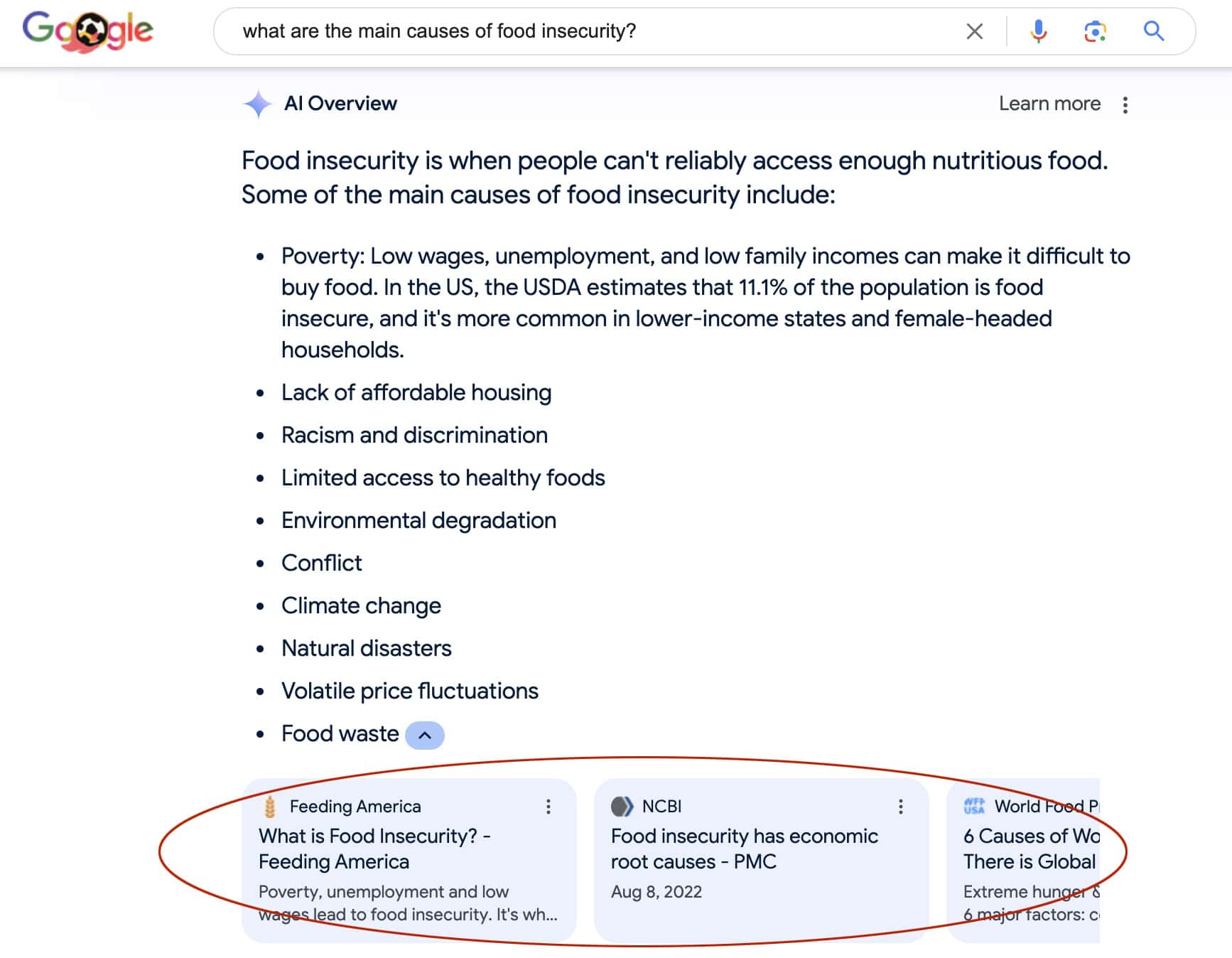July 2, 2024
AI Search Has Arrived. Here’s What That Means for Your Cause.
If you’ve searched Google recently for information on some general topic, chances are you saw something like this:

See that “AI Overview” note at the top? That means that for this particular query, Google is not relying solely on delivering a list of third-party websites – but on Artificial Intelligence – to provide the answer. And this new experiment is causing people to freak out.
The Coming of the AI Website “Apocalypse”
Suppose your nonprofit relies heavily on search to drive traffic to your website. In that case, the reason for concern is obvious: if Google is going to use AI to produce the comprehensive answer for any user’s need, what will happen to your search traffic (and what’s the point then, of even having a website)?
Initially, I too felt this concern as I listened to some of the brightest minds in marketing worry about the death of the web and SEO. But with some research and reflection, I’m realizing that not only is this concern unfounded – it misses the opportunities for nonprofit marketing that are inherent in Google’s move.
How Your Nonprofit Will Thrive in the Age of AI Search
Whenever a fundamental shift in technology occurs, it helps to take a step back and look at the broader implications of how that shift may affect your organization. Seen in the proper light, the onset of AI-enabled search turns out to be a net positive for your cause. Here’s what I mean:
Google is now competing with AI search. They need your website to win.
It’s always been the case that Google wants as many people as possible to search on their platform. That’s now become an even bigger priority since people are beginning to rely on AI search platforms like ChatGPT and Anthropic to get their questions answered. Accordingly, Google wants to give searchers a superior experience, and given their roots in search, they’re uniquely positioned to do that.

To that end, Google’s now incorporating both AI-powered answers, plus additional resources (what Google calls “helpful jumping off points to web content”) and allowing users to ask follow-up questions that, in turn, provide more resources. The experience is akin to having an ongoing conversation with an expert.
This whole model relies, in part, on websites. First, Google is basing their initial, AI-enabled answer – like the World War II example above – on content they’re pulling from websites. They’re then providing additional links to related and supporting website content.
This set-up offers opportunities for the nonprofit that’s willing to put in the work. First, there’s the chance to be cited by Google as one of the sites that’s forming its AI-enabled answer. But, even if you can’t reach that highly-sought position, there’s still a chance to be listed as a “supporting” answer as part of Google’s overall search experience.

Will your site be the one Google features in its AI search results?
In this regard, things haven’t changed from previous search iterations. In order to achieve that top slot, your content and your website have to be superb, providing the “best” answers in the form of the highest-quality, most useful content to answer a specific question.
This is a valuable goal to work towards. Achieving it not only means more traffic to your cause, but the actual work of creating great content compels your organization to become thought leaders in your field, showcasing proven expertise and highlighting relevant offerings within your niche. (If you need assistance with getting started on this path, drop us a line).
In short, with or without achieving the “top spot,” Google’s move into AI-enabled search is actually going to help you run a better nonprofit if you’re willing to commit the time and discipline to developing the content your audiences are seeking.
How Should My Nonprofit Adapt to AI Search?
Changes in AI are happening so rapidly that we can’t predict where things will be even just months ahead. But, from what I’m seeing now, the principles for success in AI search don’t differ from previous iterations of search. Here’s how we’re advising clients to take advantage:
1. Lean into search
Irrespective of who “wins” the search wars, all of this improvement in search means one thing: more people will be searching, and that’s a win for your organization. So, learn as much as you can about the various platforms and experiment for yourself. In addition to regularly searching on Google, explore tools like ChatGPT and Anthropic’s Claude to see how all three platforms operate. Envision how a prospective audience member would use these tools to find your cause and then consider how your cause’s website, marketing or content could appear in a Google search.
This top-down approach is a good way to plan the types of content you should be talking about on your website and other channels, which you can then hone into a process of regular writing and/or video development. The point here is to get involved; learn and participate in the tactic. The more adept you become, the more opportunities you’ll discover.
2. Think about your value
In marketing your cause, you should always be thinking about two things:
1. What is our mission, and how are we defining and presenting that mission to the world?
2. Who are our audiences, and what draws them to our mission?
The intersection of these two questions defines the value of your cause. For example, our client SpreadMusicNow is dedicated to providing music education to underserved youth in Connecticut. They draw support from teachers and parents within that community. Or, let’s take the New Jersey Conservation Foundation, dedicated to preserving natural spaces from development and whose audiences tend to be hikers and those passionate about environmental stewardship.
Each of these organizations understands what they do and whom they serve. They know why their audiences are drawn to them. Accordingly, any content they produce: blog posts, videos, emails, or social posts all focus on serving those audiences.
AI-enabled search is actually going to help you run a better nonprofit, if you’re willing to commit the time and discipline to developing the content your audiences are seeking.
Regardless of what happens in the search landscape, this is the formula you should follow in deciding what to talk about in your communications. Is your message meeting the needs of those who are most attracted to your mission, and thus most valuable to your cause?
3. Make content production a habit
This is a bedrock principle. No matter what happens in search technology, you should always be publishing. Whether that’s a blog post, video, or case study, you need to provide the best quality answers you can about your particular niche – and again, this has the added benefit of making your team the experts around your cause.
Since capacity may be an issue for many nonprofits, content production can be outsourced in the form of a tight partnership with a good writer or content producer. The key is to work with this individual to produce the best, most authoritative content on a regular basis.
Remember that Search is Just one Part of Your Nonprofit’s Marketing
With all of the hype around AI, it’s easy to place too much emphasis on search as a marketing tactic. While an important part of your overall marketing strategy, it’s just one pillar.
As we’ve discussed before, donors give based on factors like trust, mission, and impact. Your nonprofit’s website, first and foremost, is meant to tell the story of your cause – to immerse potential supporters and program recipients in your mission, and thus inspire them to give.
Supporters will want to know about your cause irrespective of where they heard about you – so in the end, they will find you. Search is helpful in that regard, but it’s not essential to your existence.
Still, AI-enabled search offers exciting possibilities to help your cause grow, and it’s only going to increase in usage and functionality. I encourage you to explore and experiment with these tools and channels. Understanding and harnessing the potential of AI-enabled marketing will help your cause thrive across key areas like fundraising, communications, and audience development.
TAGS:
Visiting?
Here we are.
350 Springfield Avenue #200
Summit, NJ 07901
info@bcsinteractive.com
973.377.1175
Are you ready to learn?
As a digital marketing agency for nonprofits, we write about the work and campaigns we produce, and share what we’ve learned along the way.
Count Me InSubscribe to the Blog
Sign up for monthly marketing insights you can put to use right away.
Subscribe Here